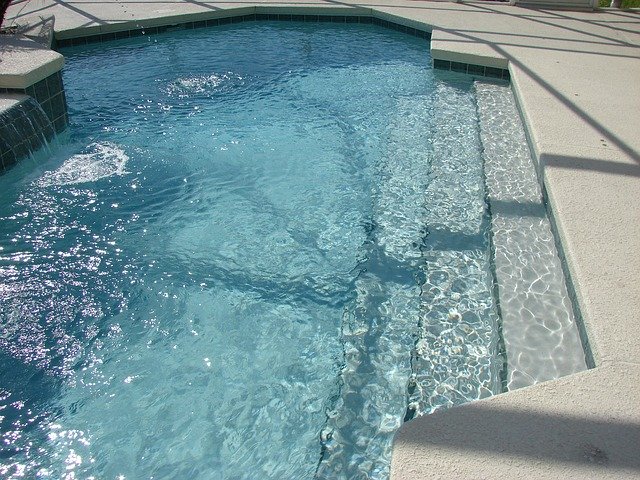How to Keep Your Pool Water Crystal Clear


Pool Water Treatment Processes
Swimming pool water is contaminated by swimmers and other environmental factors, which are in a suspended and/ or dissolved state in the water.
Some common pool contaminants
Sweat, Spitting, Nasal & pharyngeal products
Skin, hair, dandruff
Cosmetics & Medications
Urine & Faecal matter
Bird droppings
Leaves & vegetation
Algae, Biomass,
Micro Insects, worms
Water-borne chemicals,
Dirt & Debris
Swimming pool water therefore needs go through a variety of purification processes in order to keep it clean and safe.
Basic Swimming Pool Chemistry
PH is one of the most important factors in pool water balance. The water’s pH is a measure of its acid – alkalinity balance.
The pH range goes from 0 – 14. with 0-6 indicating acidity, 7 neutral and 8-14 indicating alkalinity.
In chemistry terms water that has more free hydrogen ions is acidic, water that has more free hydroxyl ions is basic. Since pH can be affected by chemicals in the water, pH is n real indication of water as it changes chemically.
The ideal level for swimming pool water is between 7.2 and 7.8
Why is pH so important?
The pH value affects the amount of hypochlorus acid (free available chlorine) that is formed, and therefore determines the effectiveness of the chlorine as a killer of bugs.
At pH 6.5, 90% of the chlorine will be hypochlorous acid
At pH 7.5, 50% of the chlorine will be hypochlorous acid
At pH 8.0, 20% of the chlorine will be hypochlorous acid
You cannot run your pool at pH 6.5 – it would acidic enough to corrode the metal fittings in your pool circulation system and it is too far from the body’s pH of 7.4. Too acid and your pool water may erode copper fittings and other metals heat exchangers leaving metal oxides which may even change the colour of the hair.
The compromise is 7.2 to 7.6, preferably midpoint of 7.4. If you let the pH drift out of this range, you will have to use more chlorine to get adequate disinfection.
If the pH is too high your eyes sting and scale starts to form in the pool, this calcium carbonate will give the pool a cloudy appearance.
The other thing to consider when adding chemicals to your pool is total alkalinity.
Total alkalinity is a measure of the amount of alkaline materials in the water. This alkalinity will usually be present as bicarbonates, but with a very high pH carbonates and hydroxides can be present as well.
Put simply total alkalinity acts as a buffer for your pH levels.
It is a measure of the pH-buffering capacity, or the water’s resistance to a change in pH. This resistance to change in pH is due to the presence of the family of carbonate ions, but certain other compounds also provide buffering. You must control both the amount of carbonate alkalinity and the pH to provide enough calcium carbonate to saturate the water without having so much that scale forms.
The alkalinity does not have to be tested as regularly as pH but is worth keeping an eye on in order to make it easier to stabilise the ph.
The appropriate range for Total Alkalinity in pool water is between 75 and 120 ppm (parts per million). High Total Alkalinity (above 120 PPM) will allow your pH to slowly creep up and resist efforts to change.
Low Total Alkalinity (below 75 PPM) allows your pH to “bounce” from one extreme to the other, making it very difficult to keep your pH in the appropriate range.
Ideal Total Alkalinity (between 75 and 120 PPM) can be achieved by adding Alkalinity Increaser if the Total Alkalinity is below 75 PPM and pH Reducer if Total Alkalinity is above 120 PPM now for the third factor affecting your swimming pool water chemistry.
Total Dissolved Solids
This is everything dissolved in your pool water including the metals,chlorine,alkalinity, sulfates and salts. This apparent contradiction in terms refers to conductive chemicals that can accumulate in the pool particularly when the water evaporates, or when the pool does not contain enough water.
Although you cannot see them they can corrode metal parts and are mostly made up of chlorides and sulphates.
Chlorides can accumulate with long-term use of sodium hypochlorite. Regular addition of alum based clarifiers (aluminum sulphate) and dry acid (sodium bisulphate) can increase sulphate levels. Periodic backwashing and water replacement are the best ways of controlling
The acceptable range of TDS in a swimming pool 1,000 to2,000 ppm.
Turbidity
Turbidity is the concentration of undissolved, suspended particles present
In order to improve the turbidity of your pool water, use coagulaters These include calcium hypochlorite, chlorinated isocyanurates, and sodium hypochlorite. They will force the particles together and allow the filter to clear them
There are several different methods available to treat your swimming pool water
Physical Barriers
Screens – These are used to filter the water and at the beginning of the process. They remove solid particles from the water.
Sand Filtration – The filter in this case is made of a multiple layer of sand that varies in size. When the water flows through the sand, solid particles are filtered out. Some particles are not filtered out using the sand filter, so secondary filtration is sometimes added.
Cross Flow Filtration a permeable membrane to filter out salts and some dissolved matter. There are several membrane filtration methods depending on the contaminant that is to be removed from the water:
Microfiltration – This type of filtration is designed to remove very small particles from the water that range in size from 0.1 to 1.5 microns. It is able to filter out suspended matter and some microorganisms.
Ultrafiltration – This type of filtration removes even smaller particles from the water that range in size from 0.005 to 0.1 microns. Not only does it remove suspended particles but it can remove other smaller substances such as salts and proteins.
Nanofiltration – This type of filtration removes particles from the water that range in size from 0.0001 to 0.005 microns. This means it is effective at filtering out viruses, herbicides and pesticides from the water.
Reverse Osmosis – This type of filtration is effective at removing the smallest of particles with a size of up to 0.001 microns. It can remove metal ion particles and dissolved salt.
Chemical Methods
There are many different methods of purifying swimming pool water using chemicals:
Chemical Addition – You can add certain chemicals to your pool water to combat specific problems. You can add agents to prevent hard water problems.
Oxidising agents are effective at killing certain microorganisms and reducing agents can be added to neutralise the oxidising agents to prevent harm to humans. They prevent erosion of purification membranes and neutralise substances such as chlorine and ozone.
Clarification – This process removes suspended solids through a number of different processes. Coagulants are first added to reduce ion charges, causing smaller particles to stick together to create bigger ones. These larger particles are then removed through a gravity filter. This method is effective at removing large particles but may not filter out all of them, further treatment may be needed.
Deionisation and softening – Ion exchange systems absorb certain anions and cations in order to deionise the water. The cations and anions are replaced by counter-ions until the tank is saturated with ions. The ion-exchanging device then needs to be regenerated with the use of certain chemicals. Water softeners are often used as ion exchangers; they work by removing calcium and magnesium ions from the water, and then replaces them with positively charged ions. This reduces the hardness of the water.
Disinfection
Disinfectants are used to kill any remaining microorganisms in the water; it is an important process of water treatment as it can prevent pathogenic microorganisms from causing human disease. There are many ways to disinfect your pool water:
Chlorine disinfection – Chlorine is capable of killing many microorganisms, but when it reacts with substances that may be present in the water, dangerous carcinogenic chemicals may be formed. This problem can be overcome by using chlorine dioxide which is effective at low concentrations.
Ozone disinfection – This type of disinfection works by using oxygen atoms to destroy particles through oxidisation. This is an effective method to kill microorganisms and is not harmful to human health.
UV-radiation – This type of disinfection is growing in popularity. It is more natural in its way of killing microorganisms as it uses UV rays to kill germs.
Biological Methods
Water purification can also be done biologically using microorganisms such as bacteria. These microorganisms decompose organic matter within the water and therefore reduce the amount of organic suspended matter. There are two types of treatment that use either anaerobic or aerobic bacteria.
Share to: Facebook Twitter LinkedIn Email
More in family, health, heating, swimming pools, work
By FrenchEntrée
Leave a reply
Your email address will not be published. Required fields are marked *



